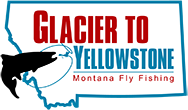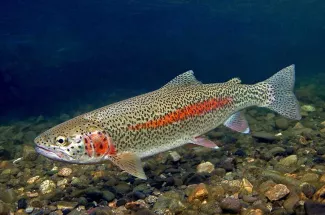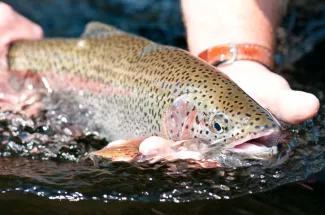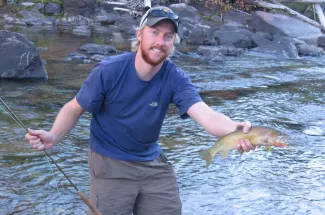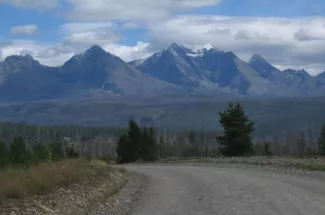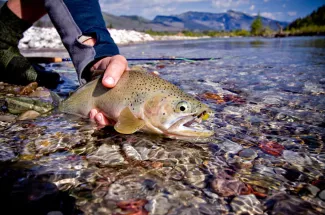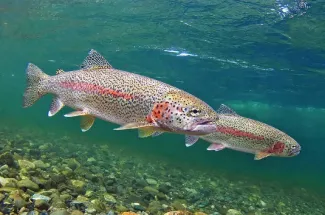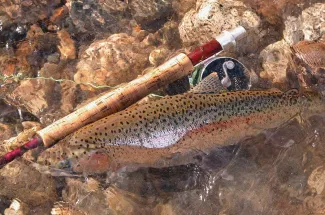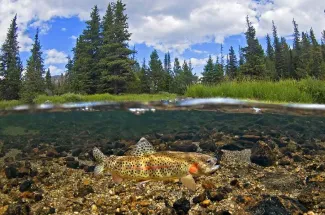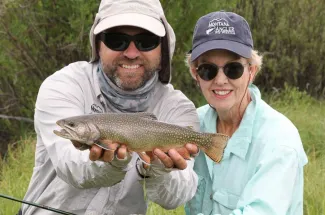While not as well known for fly fishing as other parts of the state, Northwest Montana offers some good opportunities for anglers, as well as incredible views of the soaring mountains of Glacier Country. Many of the rivers here act as nurseries for the numerous large lakes and reservoirs found throughout this region. In these fisheries, small trout are encountered all year, while larger fish move in and out seasonally. Many of these rivers drain the high country in and around Glacier National Park, producing spectacular aquamarine colored water. While beautiful to look at, these waters are not especially fertile. Though this does keep trout and insect populations relatively low, the upside is that the fish tend to be very opportunistic feeders. This country is also the dominion of native species, and Westslope Cutthroat Trout are abundant throughout many of the river systems.
Northwest Montana Rivers
This small river flows into the Clark's Fork/Noxon Reservoir just east of the Montana/Idaho border. The Bull experiences a short float season during high water in early Summer, but anglers will be limited to wading the rest of the year.
Located near the town of Libby, MT, this large tailwater is one the best and most popular fisheries in Northwestern Montana. It is perhaps best known for producing the Montana state record Rainbow Trout, which tipped the scales at over 33lbs. The average 'Bow, however, runs in the 12-14 inch range. The Kootenai sports abundant public access for wade fishing, and its large size makes it a perfect candidate for float fishing out of a drift boat or raft.
Closely paralleled by US Highway 2, the Middle Fork serves as Glacier National Parks southern boundary for a great distance. This stretch offers great access for both wade and float anglers. The headwaters rise deep in the Bob Marshall Wilderness, many miles from the nearest road or town. This section contains some serious whitewater, and is one of the best multi-day floats in the state. Fishing is good throughout, with smallish Cutthroats being plentiful, and some surprises that swim up from Flathead Lake lurking as well.
Flowing into the US from Canada, the North Fork serves as Glacier National Park's western border. A dirt road roughly follows the rivers entire course from Columbia Falls, MT up to the US/Canada border. Access for both wading and floating can be found throughout. Like the Middle Fork, most of the Cutthroats run on the small side, but larger fish out of Flathead Lake move in and out throughout the year.
The South Fork of the Flathead is one of the crown jewels of Montana wilderness and trout fishing. Located deep in "The Bob", the great effort required to reach these waters ensures the quality of the fishing. At the same time, Hungry Horse Dam acts as a buffer to the rest of the Flathead system, meaning that only native Cutthroats and Bull Trout are found here. This is one of last major streams in Montana void of non-native fish. While there is limited road access, fishing most of the South Fork is a serious wilderness undertaking.
The Spotted Bear is a small tributary of the South Fork Flathead above Hungry Horse Reservoir. The lower end is accessible from the long, dusty road around the reservoir at the Spotted Bear Ranger Station. The stream quickly ascends into the wilderness and access is by foot. This is an excellent fishery for 10-14 inch Westslope Cutthroats.
Not to be confused with the more well known river in Southwestern Montana, this version of the Stillwater drains a large area west of Whitefish and Kalispell. Although it is known more for its Northern Pike fishing, the Stillwater does have some trout in places, and many of its tributary lakes and creeks offer good fishing as well.
This swift freestone stream drains the densely forested Swan Valley, which lies beneath the towering Mission Mountains to the west and Bob Marshall Wilderness to the east. Cutthroats and Rainbows in the 8-12 inch range fall victim to dry flies, while larger fish are sometimes taken on subsurface offerings. Wade access is fairly limited and the Swan is big enough to float, but numerous log jams and sweepers discourage all but the most experienced oarsmen.
This tributary of the Clark's Fork provides good fishing for Rainbows and Cutthroats with a few Browns in the mix as well. The upper reaches of the river are small with a very low gradient. The river gains volume and steam as you move downstream, with miles of delightful pocketwater available to fish. Access is good throughout. The Thompson is known for its Salmonfly hatch in early summer, which is one of the best in this region of the state.
Located in extreme Northwestern Montana not far from the Canadian border, the Yaak is located in a very isolated and secluded area of the state. The stream is notable for being one of a very few places in Montana where Rainbow Trout are natives. The upper reaches of the stream are quite placid, while the lower end above the confluence with the Kootenai contains a canyon with some major whitewater.
